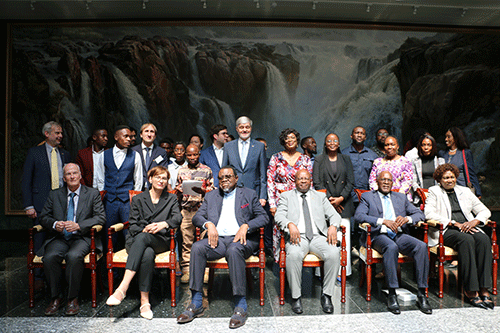German Minister of Education and Research, Bettina Stark-Watzinger said the future of climate neutrality belongs to green hydrogen. She made these remarks yesterday in the capital at the launch of Green Hydrogen Namibia pilot projects and the awarding of youth programme scholarships to beneficiaries.
“Namibia has outstanding conditions for the cost-effective production of green hydrogen and the development of hydrogen supply chain. It has ideal wind and sun conditions, large areas available, and stable democracy,” said Stark-Watzinger.
Stark-Watzinger added Namibia can supply itself with renewable energy while also profiting on a huge scale economically from the export of hydrogen. She noted that with Germany being an importer of energy, Namibia can benefit tremendously from this relationship, particularly in terms of technological advancement.
“This will be a win-win situation for both countries. The task now is to overcome technological hurdles on the path toward a hydrogen supply chain and test out the production of applications for the first time,” said the German minister.
Namibia took the first step to position itself at the forefront of world-wide aspirations for green hydrogen production in 2021 by setting in motion plans to develop the country’s first vertically integrated green hydrogen project in the Southern Corridor Development Initiative.
At the launch, National Planning Commission (NPC) director general Obeth Kandjoze, said Namibia’s green hydrogen ambition is premised on Harambee Prosperity Plan II, which is a fast-tracked action plan towards economic recovery and inclusive growth in which Namibia aspires to provide growth stimuli to its economic sectors. Additionally, the green hydrogen ambition is Namibia’s response to socio-economic challenges, such as income inequality, and enables the country to explore green growth pathways for Namibia, with the aim to become the first carbon–neutral African nation.
“In actualising that ambition, Namibia has cast hand to wheel to implement the national green hydrogen and green ammonia strategies, while harnessing its abundant renewable energy resources such as solar, wind, and hydro for renewable power production,” he added.
According to him, nine proposals from six global, regional, and local players were received and Hyphen Energy was selected as the preferred bidder to develop the two land parcels on offer. The DG noted that Hyphen submitted a comprehensive offer to conduct feasibility studies and if those prove viable, to develop a two–phase multi-billion-dollar project with the first phase expected to enter production in 2026. “That phase will see the creation of two gigawatts (GW) of renewable electricity generation capacity to produce green hydrogen for conversion into green ammonia, at an estimated capital cost of US$4.4 billion equivalent to N$80.1 billion,” outlined Kandjoze.
Further expansion phases in the late 2020s will expand the combined renewable generation capacity to 5GW and 3GW of electrolyser capacity, increasing the combined total investment to US$9.4 billion (about N$171 billion), and green hydrogen production to 300 000 tonnes.
Through the strategic deployment of research and development, targeted stimulative investment, and pilot projects, he added three other hydrogen valleys may emerge over time. These will be the subject to the Namibian Synthetic Fuels Strategy currently being developed by the Ministry of Mines and Energy.
The successful pilot projects launched in the Erongo Valley are the Dâures project (agriculture), Namport applications (logistics), Cleanergy project (refuelling) and TransNamib project (logistics).
Mines minister Tom Alweendo said the Dâures project, which was launched this week, intends to develop Africa’s first green hydrogen village that profiles hydrogen use.
This project will integrate application technologies for the utilisation of green hydrogen in agriculture, ammonia nitrate, and cleaning detergents, and also fuel cell-operated centre pivots, boreholes, and houses.
The last phase, Alweendo said will focus on providing industrial-level production for local consumption and international exports.
Emanating from a joint communique of intent (JCOI) in August 2021 between the Namibian government and the German education and research ministry, some 30 million euros (close to N$500 million) were reserved for bilateral domestic green hydrogen pilot projects grounded in research.
Scholarships
About 1 128 applications were received and only 93 Namibian youth were awarded scholarship certificates yesterday.
Stark-Watzinger stated there will be another round of scholarships in the second half of this year.
“Research and education are the keys to opening the doors to the future and green hydrogen is the game changer to save our planet,” said Stark-Watzinger.
Minister of higher education Itah Kandjii-Murangi said the Namibian youth for green hydrogen scholarship programme was born out of the partnership between Namibia and Germany. The programme was designed to ensure an output of trained young Namibians is ready to take up positions in the emerging green hydrogen industry.
The German government allocated an amount of five million euros for scholarships for Namibian youth in Germany or in programmes in collaboration with German institutions. The funding priority areas, the minister stated, were technical and vocational education training, master’s degree programmes, and upskilling of current graduates through relevant short courses.
During a courtesy call yesterday by minister Stark-Watzinger, President Hage Geingob said the past seven years were very hard for Namibia and thus he wants to leave the country in good shape when his term ends next year.
He urged Namibians to stand up and grab opportunities when they are available and not sit idle and complain later.
-mndjavera@nepc.com.na


